Managed Forex Accounts vs. Copy Trading
When researching managed Forex accounts, you may come across a lot of content related to Forex copy trading. While both options involve delegating trading decisions to others, there are key differences between the two that are important to understand.
Managed Forex Accounts
In a managed Forex account, a professional manager or firm handles all trading decisions on your behalf, tailoring the strategy to your specific investment goals, risk tolerance, and market conditions. The manager will execute trades, and you generally won’t have any direct involvement in the day-to-day decisions. Managed accounts often come with fees based on performance or a flat management fee. These accounts are ideal for investors who want hands-off exposure to the Forex market.
Forex Copy Trading
On the other hand, Forex copy trading allows you to select a trader or strategy to follow, and your account will automatically copy their trades in real-time. You retain control over your account and can stop copying a trader at any time. Copy trading typically involves lower fees or no fees at all compared to traditional managed accounts, and it offers greater transparency as you can see the exact trades being copied.
Why the Confusion?
Many Forex brokers now promote copy trading as an alternative to traditional managed Forex accounts. This is because copy trading offers a more accessible, flexible way for individuals to participate in Forex trading with less involvement and often at a lower cost. As a result, copy trading has become a popular option for investors who want to leverage the expertise of others without fully handing over control of their account.

What Is A Managed Forex Account?
Forex managed accounts are foreign currency exchange trading accounts that are operated by professional traders and are administered by a forex account management service on behalf of the investor. The management service charge performance fees and sometimes an administration fee for their provision. The client issues the forex broker with an LPOA (Limited Power Of Attorney) to allow the trader to carry out trading. The client has complete control of their account and can deposit and withdraw funds, and close it when they wish.
Introduction
If you are new to the alternative investment of forex managed accounts or even if you just want to discover a bit more about them before investing in them, you may be finding that it can be quite a daunting job.
The concept is simple enough, locate a service, hand over your investment, let the traders’ buy and sell for you, and then you reap the rewards.
Of course, it is a lot more complex than that.
This webpage is designed to help you discover the answers to your questions. I have invested in four up to this point, in the UK and overseas, so I am quite experienced with them. I have written down everything that I know about them in the article below.
I hope that you find it useful.
Find out more about copy trading where you can choose the trader to copy the trades from automatically.
If you want to compare performance results and fees of managed forex accounts providers, follow the link below and fill out the form on the next page. You will receive up to 4 bespoke FREE quotes from top-ranking fund managers that best matches your requirements
Choosing a Forex Managed Account
After you have made the decision to invest in one of the top 10 forex managed accounts, you are going to have to unearth one that fits your needs. You will need to think about your tolerance to risk, the benefits that they offer and then do your homework on them.
Step 1. Risk Tolerance
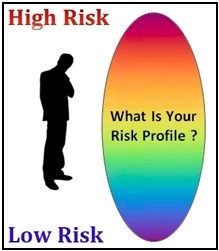
The managed forex service which is best for you depends on many factors, including the level of risk you can tolerate. The best one for you also depends on factors like your investment goals and time horizon.
The Two Aspects of Risk Tolerance
If your risk tolerance is low, you’ll likely choose a safer portfolio with lower return potential. If you have a high-risk tolerance, you’ll likely choose a riskier portfolio with greater return potential.
To find out your risk tolerance, answer the following questions:
► How much risk can you handle?
► What level of risk do you want to manage?
Ability to Tolerate Risk
Your ability to tolerate risk, also called financial risk tolerance, is your ability to handle an investment loss. If your investments are so risky that you would have to reduce your standard of living in the event of a loss, you may be taking too much risk.
Your ability to tolerate risk depends on your wealth. Wealth refers to both your financial wealth (investments and savings) and your human capital, in respect of your ability to earn employment income. This income can help you offset investment losses. High net worth investors can generally take on more financial risk.
You want your portfolio to be efficient, i.e. you want the best average return account whilst considering the highest level of risk you are willing to accept.
For instance :
A young, educated investor with no debt expects to work for 40 years before retiring. She has the time and the human capital resources needed to compensate for the losses. So she feels comfortable investing
£10,000 in a portfolio with a high level of risk.
A retired investor has a monthly income budget for his expenses. Financially, he can’t afford to lose £10,000 without risking the monthly income he needs to cover his expenditure. He does not have the time or the human capital that the young investor has to recoup the losses.
Willingness to Tolerate Risk
Your willingness to tolerate risk, also called psychological risk tolerance, is the emotional aspect of investing. If you are worried about the level of risk in your portfolio, you may have accepted more risk than you are willing to tolerate. To ease your stress, you might consider reducing the risk level of your account.
It’s easy to over estimate your willingness to tolerate risk. Research has shown that an investor’s attitude and behaviour should not be over estimated, when it comes to risk-taking.
Behaviour is more influenced by past investment experience and beliefs about the future. Think about the last time you dealt with an investment loss: how did you react? If you had difficulty accepting this loss, consider reducing the risk level of your portfolio.
Set your portfolio risk at the lowest level of your ability and willingness to tolerate risk.
Relationship Between Ability and Willingness to Tolerate Risk
You should consider these two elements of risk tolerance before making an investment decision.
For instance :
A wealthy female investor can afford to risk £10,000 by investing in a managed forex account. Even if the investment loses all of its value, her standard of living will remain the same. However, if the idea of losing this money worries her, she should refrain from investing.
A retiree with some savings and low pension income is willing to take the risk of investing £10,000 in a managed account. A loss of money, however, would mean that he could no longer maintain his current standard of living. He cannot tolerate the loss financially; he should therefore, not make the investment.
Your risk tolerance is just one factor to consider when choosing your account.
Point to Remember
To determine your level of risk tolerance, consider both your ability and your willingness to tolerate risk.
If you want to compare performance results and fees of managed forex accounts providers, follow the link below and fill out the form on the next page. You will receive up to 4 bespoke FREE quotes from top-ranking fund managers that best matches your requirements
Step 2. Managed Forex Account Benefits
Now that you feel comfortable with your risk profile, you can check out a few accounts to see what benefits they can offer you. Before investing some money into a forex managed service, you will want to know about the benefits that they can offer you so that you can weigh them up against the other types of investment.
High Returns
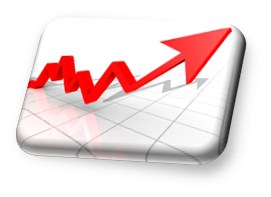
First and foremost we want our capital protected but obviously the reason that you and I want to invest in the best performing forex managed accounts is to make money. A well-run account can make you a lot of money over time. The returns that you can achieve every month far outperform what most traditional investments make every year.
Even starting with a minimum account opening balance of usually $10,000, you could expect anything from 2% to 10% or more every month. (Those investors with millions to invest can expect to receive hundreds of per cent profit every year). Even if the average returns were 5% per month, the compounding effect over time is astonishing.
Great returns are what we want but you will have to consider the overall package, rather than base your decision purely on what the previous two years trading statements say that we could potentially make.
As I said earlier, the greater returns are generally made when you take on more risk, greater drawdowns and larger lots. Also, think about the fees that are deducted.
For example :-
Imagine averaging 10% per month over the last two years. If you had a starting capital of £10,000 and the fees were 50%, you would end up with £17,958.56 at the end of Year 1. Not bad.
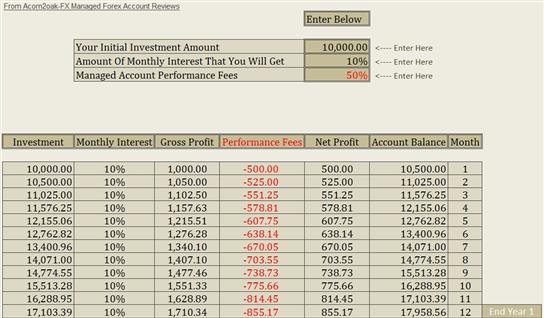
However.
If they were 25% and not 50%, at the end of Year 1, you would have amassed £23,817.80. That’s better.
This amounts to a further 58.59% gain.
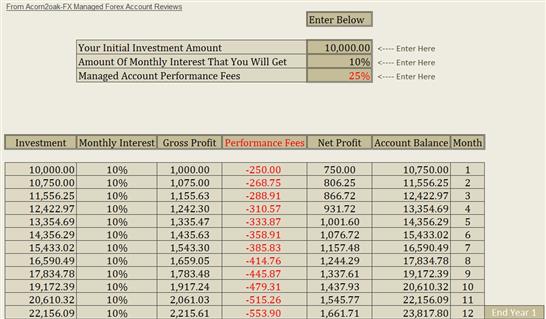
You would be more profitable than the first example if the account was averaging out at lower 7% per month and they were 25%. This would leave you with £18,478.44.
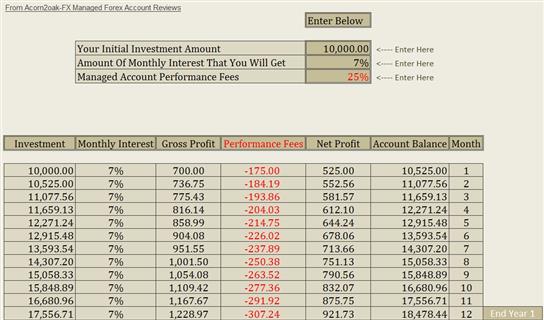
So, by all means try to get the best returns you can BUT take risk and fees into consideration also.
Low Drawdown Limit
You will have addressed this issue as you were deciding on your risk tolerance. Ideally you will want as low a drawdown as possible, even for a high risk profile.
Forex managed accounts will, or should, have a drawdown limit, for example 40%. This means that when it reaches the drawdown limit of 40% it will stop opening new positions or it will close out all of the open ones. You will need to confirm this with the forex account manager.
It is a difficult decision because if all the positions were closed at 40% and then soon after the trades changed direction and went on to win a big returns, you will be quite unhappy I suspect. However, if they went on to lose another 40%, you would be pretty pleased.
There are those now where you can set your own drawdown limit so this is a great option if you can locate one.
Low Starting Capital Needed
Look out for accounts that have a minimum opening amount requirement that fits in with your investment amount.

These days, the normal opening amount has come down to £10,000 GBP. In fact, I have seen it decreasing further and £5,000 GBP is becoming increasingly more common, in some cases even less than this.
When these FX managed accounts first started, they normally were only available to large investment companies or groups and weren’t available to individual investors, and the starting capital requirement was upwards of £100,000 GBP.
Nowadays however, with the advent of the internet and fast broadband connections, it has made it really easy to open up a fund. With ease comes popularity and with popularity comes increased competition for business.
Low Performance Fees
The management will deduct a performance fee for their services, and they vary considerably. I have paid from 25% up to 50%. They that are most commonly charged are 25% to 35% although I have my eye on one at the moment that has a low fee of only 15%, and that has only recently gone up from 10%.
Don’t dismiss the higher charges out of hand though because they could have some exceptional returns and they may suit you better, for example if have a lower risk profile.
Obviously I would want to choose an account with as lower a fee as I could get but if it doesn’t fit in with your risk profile and due diligence, then you may have to settle for a higher fee. Keep looking around until you get what you want.
Profit in Any Market
Profit can be made in whichever direction the market is heading. Whether it is sideways, bullish or bearish, there are trading opportunities and the potential to make money.
If you want to compare performance results and fees of managed forex accounts providers, follow the link below and fill out the form on the next page. You will receive up to 4 bespoke FREE quotes from top-ranking fund managers that best matches your requirements
Hands-off Investment

Learning to trade forex is normally a long and complex process. Many investors don’t want to spend hours of their time learning all of the specifics and cultivating a strategy. Also, when a strategy is developed, a lot of time has to be dedicated to trading unremittingly with high attention to detail.
A forex account that is managed and traded for you will provide the investor with an investment that leaves them free of any trading responsibilities but with the benefit of high returns. Being a successful trader means emotional detachment, and that can take a long time. Having feelings and reactions to trades can mean that you will deviate from your overall strategy, and that may leave you open to losing in the long term.
Risk Control


A quality account that is run well is a low-risk investment. Risk management is the main concern for any top trader. Leading services will have a maximum drawdown limit. This limit will stop any trading beyond what the limit is set at. If the drawdown limit is set at 30%, then the account drops by 30% from its highest peak, then the account will stop trading. It is up to the investor’s risk profile as to how much drawdown they can handle. Also, traders may also have individual risk limits for every trade. For, e.g. 200 pips.
This will stop individual trades from losing too much. Good traders will have a winning percentage of trades in the region of 70% or so. The best traders may have a 90% winning trade percentage.
Your Control Your Account

Your funds will be in a trading account that is in your name, so you have total control of it, apart from the trading aspect. You can add funds and withdraw funds whenever you like. You can close the account if you feel the need to as long as you have no trading positions that are still open. The trader has access to your account purely to make the trades for you. They can’t withdraw your funds. For them to be able to trade on your behalf, you will have to give them an LPOA (Limited Power of Attorney).
Forex Is Difficult to Manipulate
The stock and futures markets can be manipulated basically because they are situated in a centralized exchange that is run by one regulator. Also, large traders can alter prices by trading high volumes. Forex is a decentralized market with no single price therefore it is far more competitive amongst the dealers. Also, because the trading volume is so vast, individual investors have very little impact on the price.
Liquidity
Many other investments such as long term deposit plans and property mean that your money is tied up for a long time. You won’t be able to get your hands on the cash immediately if you need it. From being in a trade, you would be able to close the trade to having the funds in your personal bank account in a matter of two to three days.
Leverage

Leverage is the degree that an investor can take advantage of borrowed funds. Different brokerages will have different leverage. If a brokerage has a leverage of 100:1 and you had a deposit of $1000 dollars, you would be able to trade $100,000 dollars. It possesses an enormous potential that enables you to control a lot of money that can make you very wealthy. However, it can magnify losses respectively.
Open 24/7
The forex market is traded all around the world through New York, London, Tokyo and Sydney, and it is, therefore, possible to trade 24 hours a day.
If you want to compare performance results and fees of managed forex accounts providers, follow the link below and fill out the form on the next page. You will receive up to 4 bespoke FREE quotes from top-ranking fund managers that best matches your requirements
Step 3. Due Diligence

Now that you feel comfortable with your risk profile and you are happy with the benefits on offer, the crucial part is choosing a trustworthy and dependable firm to invest your money with.
The last thing you want to do is lose your money to a bunch of scammers, and there are many about. So doing your homework on the account you feel is right for you, is essential.
Investing in the forex market carries degrees of risk and some of those risks you can bring down to a minimum by conducting quality homework on the companies.
You can normally wheedle out the scammers by doing this. What you can’t legislate for are those that don’t adhere to their policies.
I have been stung by one that had a drawdown limit of 15% but went on to lose over 98% of my money. You can read more about it here vista-fx-trading-group-review-big-no-no-for-me.
I have to point out that just because a managed account doesn’t pass all of the recommended criteria, it doesn’t mean to say that they are untrustworthy and unreliable.
It’s just that the more due diligence that you conduct, the greater the chance that your investment will not be a disaster. The main aim is NOT to lose your initial deposit and a quality management company will have this as its main objective.
There are a few ways that you do your homework on a opportunity.
If you want to compare performance results and fees of managed forex accounts providers, follow the link below and fill out the form on the next page. You will receive up to 4 bespoke FREE quotes from top-ranking fund managers that best matches your requirements
3rd Party Audit
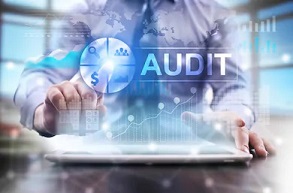
First of all you can do an investigation to see if the company has an independently verified audit report for its results.
This is a statement of trading performance from an autonomous 3rd party accountancy firm that states that the results and information are genuine and correct.
This information may be available on the website, or if not, you can contact them to see if they have one for you to see.
If they have, you can go one stage further and do your homework on the accountancy firm and then contact them to confirm the 3rd party audit.
Are They Regulated
Secondly, you can check to see if they are regulated in the forex market with the relevant regulatory body such as the FCA (Financial Conduct Authority) in the UK.
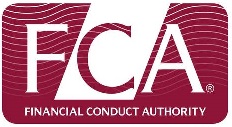
Once again, this information may be available on their website. If it isn’t, get in touch with them and ask them if they are regulated.
If they are, the next step would be to get in touch with the regulatory body like the FCA UK for example, and ask them to confirm that they are actually regulated with them and if they are in good standing.
They can trade without being regulated as it isn’t compulsory, however, you have to ask yourself why they wouldn’t get regulated because it means that they are serious about their business and it adds another level of security and legitimacy.
Trading History
The third way to do a check is to ask the forex account manager for proof of the trading history for at least the previous two years.
If they have been profitable for that amount of time then you can more or less accept that they are a worthy trader.
Bear in mind that past results are no guarantee of future achievement, just an indication.
Online Analytical Tools
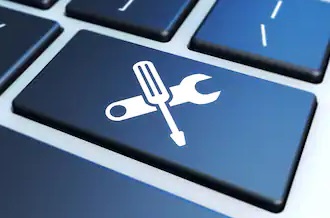
Depending on which trading platform they use, such as MT4 (MetaTrader 4), you could do it online with the help of various analytical tools such as myfxbook.com that has all historical data recorded, or can ask for actual trading accounts from the forex account management team with all of the trades on them.
With the online analytical tools, you can also check to see if the trading results are verified.
This means that they have not been manipulated by scammers. Yes they get everywhere. You will need to check how to do this on the website because each analytical tool does it differently.
Is The Broker Regulated
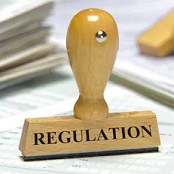
Another bit of research you can do is check to see if the broker that the trader uses is regulated.
The truth is that 99% of brokers will be regulated because it is a requirement, and also the trader will want to know that they are regulated also.
The unregulated small brokers will not last long in this business because it is highly competitive.
Once again, to check if they are regulated, have a look on their website as they will want to keen to reveal this information.
If you can’t locate the information, you could always get in contact with them to ask them. When you have the regulatory details, you can contact the regulatory body and ask for confirmation if the details are genuine.
The leading brokers are splattered all over the internet so you can usually determine the reliable ones.
Other Diligence
If the above five criteria are passed, then you will reduce your risk of being scammed by a massive extent.
There are other things you could do such as checking out forex forums such as forexfactory.com or forexpeacearmy.com and raise the question on those.
Also speaking to the company and asking them about the above groundwork will give you an idea if they are the real deal or not. You will soon find the ones to steer clear of when they avoid your questions.
How do Forex Managed Accounts Work?
Signing Up
Once you have defined your risk profile, checked out some opportunities and done your research, you should have come to a decision about which opportunity that you want to go with.
Signing up to an account is very similar whichever opportunity you have opted for. It is basically the same process but with slight variations. It is self-explanatory really and they will guide you through it.
It goes something like this.
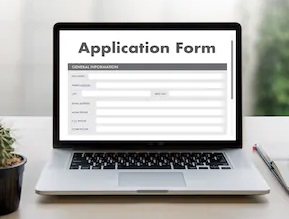
First of all you will need to go to their website and look for the account opening page where you need to fill out the form with your details.
If you leave your phone number, they may call you otherwise they will send you an email with the instructions of what to do next.
You should receive a contract to sign to agree to the terms and conditions such as the amount of the fee and the fact that they can withdraw it at the end of the period. Have a thorough read through it and if you agree to it, then sign it and return it.
You may want a lawyer to read through it to see if all is as it should be.
Normally, you will be instructed to open a trading account with the broker that you did due diligence on earlier. Go to the brokers account opening page and fill out your details.
You will get an email saying they have received your application and that when they approve it, they will get back in touch with you.
After the brokers approve your application, they will ask you to send over some identification, usually some photo id such as a scanned passport or driving licence, along with a utility bill with your current address on it.
Upon receiving proof of who you are, you will receive another email from the brokers which has an LPOA, (Limited Power of Attorney) on it, typically in the form of an attachment to print, fill out and return by email, or it may be done online using an electronic signature verification.
An LPOA, (Limited Power of Attorney) is a document that you send to the broker that enables the trader to access your trading account to conduct market trading activity ONLY.
They will have no access to your funds for any other purpose such as withdrawing monies and changing account details.
Sometimes, the above dealings with the brokers is carried out through the FX managed account company so you would be sending your identification and LPOA to them and they will sort out some of the administration with the brokers.
You will receive an email from the brokers and also the team saying that your account is activated and that you can add cash whenever you wish. There are many ways in which to fund it as all methods of payment are acceptable.
On one of the previous emails from the broker or the manager, you should have had instructions to download the trading platform that the broker uses.
If not, you will be sent instructions in another email shortly. You will receive your login details and password also.
If you want to compare performance results and fees of managed forex accounts providers, follow the link below and fill out the form on the next page. You will receive up to 4 bespoke FREE quotes from top-ranking fund managers that best matches your requirements
Trading
After your account has been credited, they are able to start trading for you. Well there is not a lot you can do apart from letting them get on with their job.
End of Month
Once the last trading day of the period has ended, you will be sent a trading statement from the broker that contains open and closed transactions, working orders and your trading summary with all of the amounts won and lost and current balance.
If your funds have exceeded the high-water mark, the fees will be deducted from the returns. They are only subtracted from the returns above the high-water mark.
What is the High-Water Mark?
You may well ask.
A high-water mark is the most amount of money that your account has ever reached after any performance related costs have been subtracted from by the FX managed account company.
Let me give you an example.
Say you opened a new trading account and the fees were 50% and you put in an initial deposit of £10,000.
During the period (1) it attained a respectable 10% gain. This equates to a monetary gross gain of £1,000.
The managed forex account company deducts their 50% fee which amounts to £500.
This leaves you with a net gain of £500.
It has now created a new high-water mark which is £10,500 made up from your investment of £10,000 plus the monthly net return of £500.

Imagine the next period (2) produced a 10% loss, the equivalent of £1,050.
The balance of your account would be £9,450. You would have nothing deducted because your balance is less than the high-water mark of £10,500.
Your high-water mark would still be £10,500.

In month 3 they produced a superb 20% return which equates to £1,890.
This takes your balance up to £11,340.
You don’t pay fees on the total yield of £1,890. You pay them on the difference between your new account balance of £11,340 minus the previous high-water mark of £10,500.
This amount works out at £840 and 50% costs come to £420.
You end up with a new balance and high-water mark of £10,920. This is made up from your previous balance of £9,450 plus £1,890 yield less £420 charges.

Only when the new high-water mark of £10,920 is exceeded will anything be deducted, and so on.
FAQs

There are many questions about the account that your trading funds are held in and I will try to cover those in this section.
► When you opened your account, it was in your name and your name alone (unless you opened it with a partner), so you own it and have total control over it.
► You are free to withdraw money at any time and this is normally done without expense to yourself. You can top it up whenever you want to add to it.
► When you want to withdraw cash, you will only be able to draw them out if they aren’t still working orders and involved in a trade. The order will have to be closed.
► You can close the account whenever you want, as long as all positions are closed.
► To add and withdraw to it, there will be a specific page dedicated to this on the broker’s website. It is a straightforward transaction, similar to any online banking transaction. All of the instructions are there anyhow to help you out, as well as customer support.
► The forex account manager nor the trader have access to your funds, apart from what you have signed up for.
► The forex managed account team can withdraw the agreed performance fees at the end of the trading period as per the contract when you signed up.
► They have access to your finances solely for the purpose of trading as per the LPOA that you signed previously.
► There are quite a few different trading platforms that different brokers use. Probably the most commonly used is MT4 (MetaTrader 4).
► These are downloaded onto your computer. You will have access to all of the activity that occurs on your account.
► Once finances are credited, then they can start trading for you on your behalf and you will be able to see it in action.
► Also available are all of the reports that you may want to see such as historic trades.
► You will not have access to the platform to place any transactions for yourself.


Great content on managed Forex accounts!
Thank you, Martin!